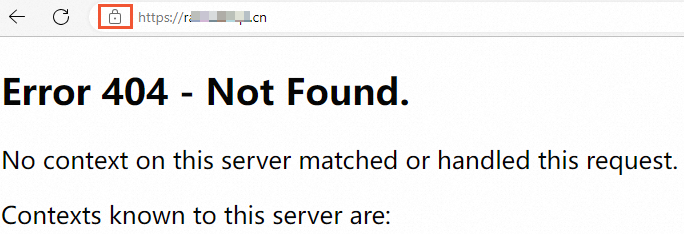You can install SSL certificates on Jetty servers to enable HTTPS-based access to web services that are deployed on the servers. This topic describes how to install an SSL certificate on a Jetty server.
In this topic, a Jetty server that runs a Linux operating system and is deployed based on jetty-distribution-9.4.51.v20230217 is used as an example to illustrate the installation. Installation operations vary based on the versions of servers and operating systems. If you have questions, contact your account manager.
Prerequisites
- A certificate is issued by using the Certificate Management Service console. For more information, see Purchase an SSL certificate and Submit a certificate application.
- DNS resolution is complete on the domain name that is bound to the certificate. The domain name is resolved to an IP address. You can use the DNS verification tool to check whether the DNS record of the domain name takes effect. For more information, see Verify the DNS record of your domain name.
Step 1: Download the certificate
- Log on to the Certificate Management Service console.
- In the left-side navigation pane, click SSL Certificates.
Find JKS in the Server Type column and click Download in the Actions column.
Decompress the downloaded certificate package.
The following table describes the files that you can extract from the package. The files vary based on the CSR generation method that you use when you submit the certificate application.Value of the CSR Generation parameter
File extracted from the certificate package
Automatic
Certificate file in the JKS format: By default, the certificate file is named in the Certificate ID_Domain name bound to the certificate format.
Password file in the TXT format: By default, the password file is named in the Certificate format-password format.
ImportantA new password file is generated each time you download a certificate. The password is valid only for the downloaded certificate.
Manual
If you specify a CSR that is created in the Certificate Management Service console, the certificate file that is extracted from the downloaded certificate package is the same as the certificate file that is obtained in scenarios when you set CSR Generation to Automatic.
If the specified CSR is not created in the Certificate Management Service console, only the PEM certificate file can be extracted from the downloaded certificate package. The password file or private key file cannot be extracted. You can use the certificate toolkit to convert your certificate file, password file, or private key file to the required format. For more information about how to convert certificate formats, see Convert the format of a certificate.
Step 2: Install the certificate on the Jetty server
Create a cert directory in the installation directory of Jetty to store the certificate.
Run the following command to go to the Jetty installation directory:
cd /usr/local/jetty # Specify a value based on the actual installation directory of Jetty.Run the following command to create the cert directory:
mkdir cert # Create a directory named cert.
Upload the certificate file to the cert directory.
NoteYou can upload the file by using the file upload feature of a remote logon tool, such as PuTTY, Xshell, and WindSCP. For more information about how to upload a file to an Alibaba Cloud Elastic Compute Service, see Use mstsc.exe to upload a file to a Windows instance or Upload a file to a Linux instance.
Open the jetty-ssl.xml and jetty-ssl-context.xml configuration files of Jetty to modify certificate-related settings.
Run the following command to open the jetty-ssl-context.xml configuration file:
vim /usr/local/jetty/etc/jetty-ssl-context.xmlIn the jetty-ssl-context.xml configuration file, find the following parameters and modify the settings based on the comments.
NoteIn earlier versions of Jetty, certificate-related parameters may be stored in the jetty-ssl.xml configuration file.

<!-- The configuration of the certificate file. Replace cert/domain_name.jks with the actual path to your certificate file. --> <Set name="KeyStorePath"> <Property name="jetty.sslContext.keyStoreAbsolutePath"> <Default> <Property name="jetty.base" default="." />/<Property name="jetty.sslContext.keyStorePath" deprecated="jetty.keystore" default="cert/domain_name.jks"/> </Default> </Property> </Set> <!-- The configuration of the certificate password. Set the default parameter to the password that is included in your jks-password.txt file. --> <Set name="KeyStorePassword"><Property name="jetty.sslContext.keyStorePassword" deprecated="jetty.keystore.password" default="zf****c4"/></Set> <!-- The configuration of the certificate keystore type. Set the default parameter to the type of the certificate keystore that is used. If the certificate is in the JKS format, set the default parameter to JKS. --> <Set name="KeyStoreType"><Property name="jetty.sslContext.keyStoreType" default="JKS"/></Set> <Set name="KeyStoreProvider"><Property name="jetty.sslContext.keyStoreProvider"/></Set> <!-- Set the default parameter to the password that is included in your jks-password.txt file. --> <Set name="KeyManagerPassword"><Property name="jetty.sslContext.keyManagerPassword" deprecated="jetty.keymanager.password" default="zf****c4"/></Set> <!-- Replace cert/domain_name.jks with the actual path to your certificate file. --> <Set name="TrustStorePath"> <Property name="jetty.sslContext.trustStoreAbsolutePath"> <Default> <Property name="jetty.base" default="." />/<Property name="jetty.sslContext.trustStorePath" deprecated="jetty.truststore" default="cert/domain_name.jks"/> </Default> </Property> </Set> <!-- Optional. Specify Transport Layer Security (TLS) protocol-supported cipher suites. You can determine whether to specify the cipher suites based on your business requirements. --> <Set name="ExcludeCipherSuites"> <Array type="String"> <Item>SSL_RSA_WITH_DES_CBC_SHA</Item> <Item>SSL_DHE_RSA_WITH_DES_CBC_SHA</Item> <Item>SSL_DHE_DSS_WITH_DES_CBC_SHA</Item> <Item>SSL_RSA_EXPORT_WITH_RC4_40_MD5</Item> <Item>SSL_RSA_EXPORT_WITH_DES40_CBC_SHA</Item> <Item>SSL_DHE_RSA_EXPORT_WITH_DES40_CBC_SHA</Item> <Item>SSL_DHE_DSS_EXPORT_WITH_DES40_CBC_SHA</Item> </Array> </Set>In the jetty-ssl.xml configuration file, find the following parameters and change the port used by the HTTPS service to 443.
NoteIn earlier versions of Jetty, the settings of the HTTPS service port may be stored in the jetty-https.xml file.
<Set name="port"><Property name="jetty.ssl.port" deprecated="ssl.port" default="443" /></Set>
Open the start.ini file in the Jetty installation directory and append the following content to the file:
etc/jetty-ssl.xml etc/jetty-ssl-context.xml etc/jetty-https.xmlIn the Jetty installation directory, run the following command to restart the Jetty service:
./bin/jetty.sh restart
Step 3: Check whether the certificate is installed
After you install a certificate, you can access the domain name that is bound to the certificate to verify whether the certificate is installed.
https://yourdomain # Replace yourdomain with the domain name that is bound to your certificate.If a lock icon appears in the address bar, the certificate is installed.

If Error 404 is reported, no web applications are deployed on the Jetty server. The error does not indicate that the Jetty server is not started.